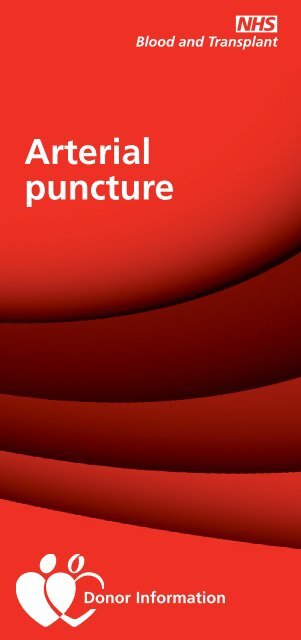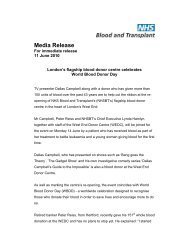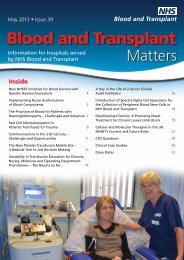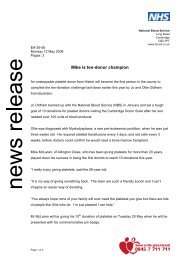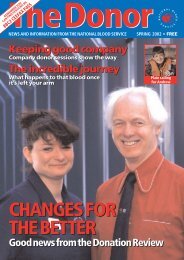Arterial Puncture (PDF, 213K)
Arterial Puncture (PDF, 213K)
Arterial Puncture (PDF, 213K)
Create successful ePaper yourself
Turn your PDF publications into a flip-book with our unique Google optimized e-Paper software.
<strong>Arterial</strong><br />
puncture<br />
Donor Information
Donor name: ................................<br />
Date of birth: ...............................<br />
Donor number: ............................<br />
Date: .............................................<br />
Time of arterial<br />
puncture:......................................<br />
Site: R / L arm (please circle)<br />
Nurse name:.................................<br />
Signature:.....................................<br />
Additional comments:
Thank you for coming to donate blood<br />
today. We are sorry that a complication<br />
has occurred where the needle was<br />
inserted into an artery rather than a<br />
vein. This rarely happens and our<br />
nurses are trained in dealing with this<br />
complication, however it is important<br />
that if there are any changes you<br />
follow the advice below:<br />
If you are experiencing any of the following<br />
symptoms, raise your arm and apply firm<br />
pressure:<br />
■ Bleeding has restarted.<br />
■ Swelling that is large or increasing in size.<br />
■ Numbness or pins and needles in the arm,<br />
hand or fingers.<br />
■ Severe or worsening pain.<br />
■ Coldness or paleness of the lower arm,<br />
or hand of the affected arm.<br />
Go immediately to the Accident & Emergency<br />
department at your nearest hospital, ask<br />
someone to take you or dial 999 and take<br />
this information with you. A letter for the<br />
A&E doctor is included within this leaflet.<br />
Continue to raise your arm and apply firm<br />
pressure over the site of needle entry on<br />
your way to hospital.
YOU MUST NOT USE THIS ARM TO<br />
DONATE BLOOD IN THE FUTURE<br />
Bruising<br />
It is likely that a bruise will appear after this<br />
has happened. The bruise may look dramatic<br />
and some people can find this worrying,<br />
especially if it appears away from the<br />
donation area. Bruises will disappear with<br />
time but this may take several weeks. It is<br />
normal for bruises to spread out before<br />
fading. If you do experience a bruise the<br />
following advice may help during the first 36<br />
hours after the bruise appeared.<br />
Treat your bruise with RICE!<br />
Rest – allow time for the bruise to heal.<br />
Protect the bruise by avoiding heavy lifting,<br />
e.g. at the gym or carrying heavy shopping,<br />
and only light, gentle movement is<br />
recommended. After 36 hours return to<br />
normal activity.<br />
Ice – do not place directly on the skin but<br />
under a cloth.<br />
Compression – pressing on the point where<br />
the needle was inserted when a bruise has<br />
appeared may reduce the size of the bruise<br />
which is forming.<br />
Elevation – if possible, raise your arm above<br />
the level of your heart when at rest.<br />
www.blood.co.uk
If you require pain relief take paracetamol<br />
(according to manufacturer’s instructions)<br />
but avoid aspirin and ibuprofen for the first<br />
24 hours.<br />
After 36 hours, contrast bathing may help<br />
reduce any swelling. This requires putting<br />
a cold cloth on the affected area for<br />
10 minutes followed by a warm cloth for<br />
10 minutes and repeating this several times,<br />
ending with a cold cloth.<br />
Further information:<br />
If you are worried or require<br />
further information you can<br />
obtain advice by ringing our<br />
donor helpline on<br />
0300 123 23 23<br />
NHS Blood and Transplant is a Special<br />
Health Authority within the NHS.<br />
www.blood.co.uk
TO WHOM IT MAY CONCERN<br />
I am sorry to have to refer this donor to you.<br />
However, at today’s blood donation session<br />
the donor received an arterial puncture rather<br />
than the normal venepuncture required for<br />
venesection. This was done with a 16 gauge<br />
needle.<br />
This is a recognised but rare complication of<br />
blood donation and the majority of these<br />
settle at the session where we manage to<br />
treat them effectively and we do not require<br />
to refer them onwards.<br />
However, a small group have continuing<br />
problems, because of either lack of<br />
haemostasis due to tearing of the artery or<br />
bleeding within the tissues, and may develop<br />
compartment syndrome, pseudo-aneurysms<br />
or just haematoma formation requiring<br />
physiotherapy.<br />
We would be very grateful if you could look<br />
at this donor and follow up as necessary.<br />
Yours sincerely,<br />
Dr S M Barnes FRCP FCEM<br />
Associate Medical Director – Donors<br />
INF809/1 BLC662P Effective date: 19/03/2012


